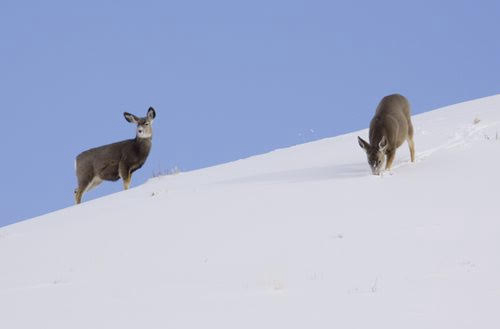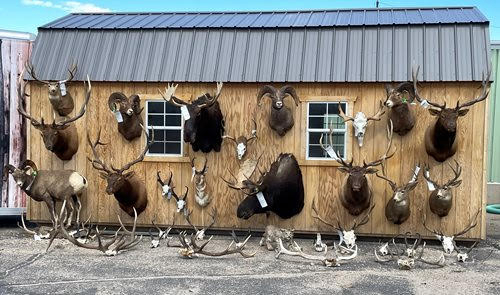Michigan Deer Hunting Forecast
What to Expect Across the State
The 2013 season saw a drop in deer harvest in the majority of the Midwestern United States, and Michigan was not an exception. Hunting success decreased somewhat across the state; though a little more than 4 out of every 10 hunters were still able to take home at least one deer last season. The biggest decreases in deer harvest occurred in the upper and southern lower peninsulas. The Upper Peninsula experienced a severe and prolonged winter in 2012, and deer harvest was expected to decline as a result. Areas in the Southern Lower Peninsula were still recovering from the Epizootic Hemorrhagic Disease outbreak that occurred in the summer of 2012. More restrictive regulations along with lower than typical deer populations led to fewer antlerless deer in particular being taken in southern Michigan.
The winter of 2013 started early and continued late into spring throughout most of the state. Record low temperatures and above average snowfall made for difficult conditions for deer, most notably in the Upper Peninsula. Some areas may see decreased numbers of fawns and yearlings as a result but overall there appears to be good survival throughout much of the Lower Peninsula regions.
The 2014 deer season is forecasted to have similar success rates to last year. Please see below for more detailed information about the area you hunt and what to expect. Though, this may help to get you started with what to look for there is no substitute for scouting. The opportunity to find out which trees are producing, what deer trails are being utilized and what patterns deer are following this year is priceless information for a deer hunter. So, whether your goal is to get meat in the freezer, go for a wall hanger or simply get outdoors, Michigan’s deer seasons offer something for everyone. Best of luck to you hunters and have a wonderful and safe deer season.
Upper Peninsula
The Upper Peninsula (UP) has experienced back to back severe winters over the last two years. This has led to decreased deer numbers throughout the region with losses occurring most notably in this year’s fawns and yearlings. Biologists recommended closing all public land and all but three private land deer management units for antlerless licenses this year in order to allow deer numbers to rebound over the next three years. The three units currently open for private land antlerless licenses are located in the south central portion of the UP which typically has higher deer populations than anywhere else in the UP. Antlerless permits are available in Deer Management Units: 055 (Menominee), 122 (Norway), and 155 (Gladstone). October 2014 3
The production of mast (fruit and nuts) in the UP has been low throughout much of the region this year. There is some acorn and apple production but it is spotty throughout the region so hunters will need to scout in order to find these areas. Although mast production was low this year there was enough rain and heat to have a productive growing season giving deer many other food sources to seek out.
In general, hunters should expect to see fewer deer, especially in the younger age classes (fawns and yearlings). Always keep in mind that each area is influenced by local factors and conditions that affect deer density and sightings in that area. The largest bucks (heaviest and largest antlers) typically come from agricultural areas, but nice bucks are also taken from forested areas where access is limited and they have an opportunity to get older.
Northern Lower Peninsula
The deer population for the Northern Lower Peninsula (NLP) is expected to be similar to last year. Even with the severe winter this past year deer in the NLP came through it in fair to good conditions.
Deer sightings have been good throughout the region and many have reported seeing healthy fawns including many sets of twins. Though it appears some deer may have been lost due to the severe winter the main impacts observed from winter will likely be smaller body size and antlers rather than lower populations.
Mast production (fruits and nuts) has been good throughout the region. High production of acorns, apples and beechnuts has been reported. Deer should be targeting these areas frequently. Scouting to find these areas will be very important. Contacting your local wildlife office may be a good first step; they may be able to give you insight as to which areas are producing.
Expect to see similar deer numbers to last year throughout most of the NLP. Many areas may see more 2.5 year old bucks this year as well since a number of NLP counties began a 3 point antler point restriction last year which allowed the majority of 1.5 year old bucks to mature to the next age class this year. All NLP Deer Management Units are open for antlerless hunting so be sure to look in the 2014 Antlerless Deer Digest if you are interested in obtaining an antlerless license.
Southern Lower Peninsula
Abundant food and cover in the form of agricultural crops and scattered swamps and woodlots provide very good habitat across the southern Michigan landscape. This high quality habitat, combined with relatively mild winter conditions, typically results in a more abundant and productive deer population compared to other regions of the state.
Over the last decade or more, deer population estimates and indices (including deer/vehicle collisions, crop damage complaints, and observations of deer by the hunting community and field staff) in the Southern Lower Peninsula have stabilized or declined. In many instances, reductions were intended to reduce conflicts that can occur when deer October 2014 4
populations are high, though the Department still desires to keep adequate deer for enjoyable hunting and viewing experiences. Repeated outbreaks of Epizootic Hemorrhagic Disease (EHD), however, have also occurred over this period. Though individual EHD outbreak sites affect deer at the scale of a township or smaller, these outbreaks have likely produced more variability in deer densities across southern Michigan than has occurred in many years. Populations in a number of locations are likely now at or closer to goal than they have been for some time and in some cases deer population should be increased. Management efforts are now being directed towards distinct areas at a smaller scale than larger, regional regulations and Deer Management Units that were formerly in place. Research is underway to improve understanding of the duration of EHD impacts that hunters and landowners should expect to see where outbreaks have occurred. Given the higher proportion of land in private ownership in this region, and the often small property sizes, the Department is working to find more ways to support good deer harvest and habitat management decisions among networks of private landowners and hunters.






